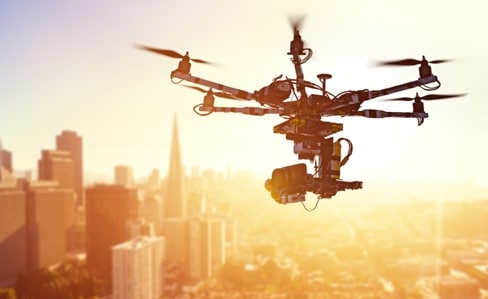The Rise Of Flying Machines: How Drones Are Transforming Broadcast And Media Production
Home » The Rise Of Flying Machines: How Drones Are Transforming Broadcast And Media Production
- January 9, 2017

If you have watched Planet Earth II (broadcasted in 2016), a follow-up to the nature series aired in 2006 on BBC – the intimate close-ups, chases and kills, and the sweeping vistas might have left you spellbound. While the voice of Sir David Attenborough still gave us goose bumps, the sights added on to the experience – making us feel right in the middle of the action.
If you’re wondering the technology behind this transformation over a decade, read on!
Cinematographers have used the latest in camera technology to create the experience. Drones! To capture those stunning panoramas and actions, drones created the magic that you witness sitting in your living room.
If you watch television with a trained eye, you’ll notice that many series, documentaries, and movies are shot using drones to provide a real-life experience to the viewers. Movies like the Expendables 3, Transformers: Age of Extinction, The Wolf of Wall Street, and Captain America are shot using drones.
Drones are becoming popular among production companies for filming shots that require adrenalin-filled action sequences, literal birds’ eye views, dramatic panoramas or 360-degree views of subjects. In fact, 2015 witnessed the birth of the New York City Drone Film Festival, the world’s first drone film festival to recognize the remarkable usage of drone in cinematography where at least 50% of the footage is shot using a drone.
Ben Sheppard, managing director of Spider Aerial Filming, sums up the advantages of drones over static cranes and expensive helicopters. “No other filming method can start a sequence inside a building and end up at 400 feet altitude in one uncut shot,” says Sheppard. Not only does drones allow the reader to build a better mental picture of the layout of the land, but it can also get down to ground level, with smaller shadows and less air disturbance, unlike helicopters.
Media and broadcast industry, particularly journalism and documentaries witnessed a revolution in 2016 as a result of the increasing capabilities of drones. After the popularity of the New York Times story on the impact of the Syrian Civil War on Aleppo that was captured using drone footage, the newspaper published a list of top stories it covered through drone footage.
CNN uses drones to augment its traditional television coverage and provide improved vantage point. The news network has also launched a team to fly and operate drones as part of expanded news coverage to provide the benefits of planes and helicopters for a fraction of the cost.
“A news story about immigration comes alive to the viewer’s when sweeping shots are taken of the presenter over the white cliffs of Dover. Or a drone flying above a car racing down a mountain road adds to the excitement when the surrounding terrain is visible,” says Sandra Hossack, Director at SkyPower – a supplier of aerial filming platforms.
As the technology matures, using drones has its set of challenges. As the US formulates the framework for legitimizing usage of drones, regulatory barriers still prevent drone adoption. Companies need permission from the Civil Aviation Authority to work with them. For example, in August 2014, during the civil unrest Ferguson, Missouri, police requested the airspace to be closed to prevent media from gathering footage. The authorities also instituted no-fly zones at Standing Rock, North Dakota in 2016 to prevent coverage of the protests and the acts of police.
Using drones is already transforming the media. It will only increase as drones become more technically able and widespread. Drone manufacturers are developing technologies like collision avoidance and geo-fencing to make flying drones safer.
A BI Intelligence report predicts drone sales to go up to $12 billion in 2021, from just over $8 billion in 2016. As authorities create regulations to permit more widespread use of drones, this trend will only increase moving forward. Drones are not just toys, but a part of the new media wave.
[1] http://www.businessinsider.com/heres-how-drones-are-transforming-news-media-2017-1?IR=T

